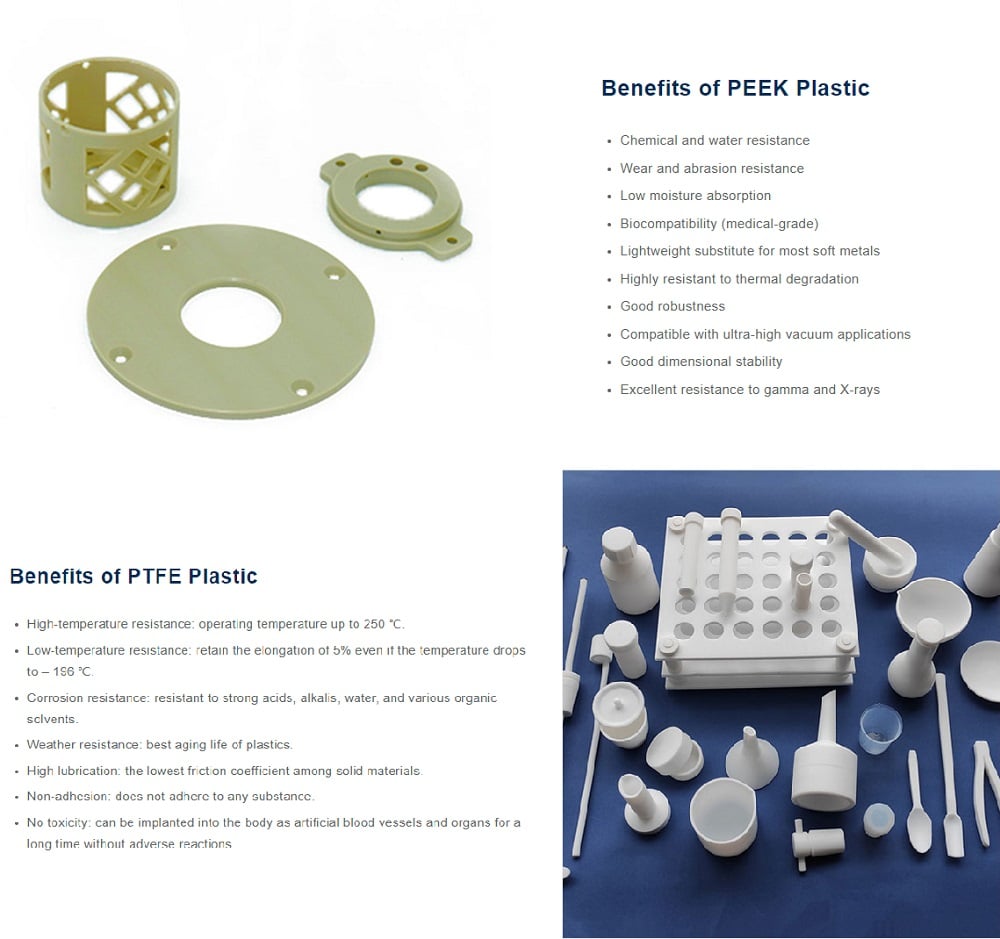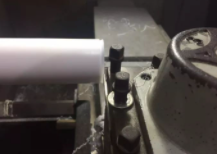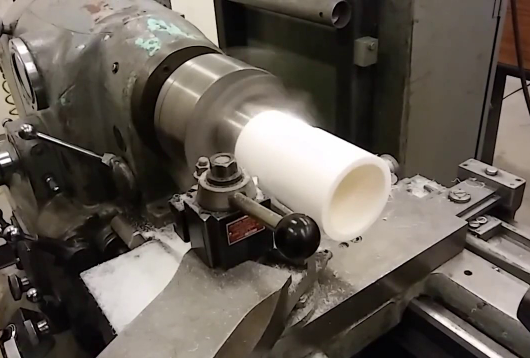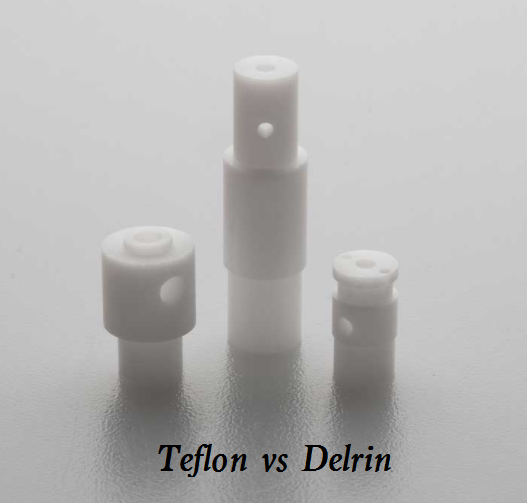Plastics are incredibly versatile materials that are utilized in a vast array of products and applications. Polytetrafluoroethylene (PTFE) and polyetheretherketone (PEEK) are two of the most commonly used high-performance thermoplastic materials in industrial manufacturing applications. Both plastics offer unique properties that make them well-suited for various engineering applications. While both offer exceptional properties, there are key differences between PEEK and PTFE plastic that make each suitable for specific purposes. In this post, we will provide an overview of PEEK and PTFE materials, highlight their key advantages and disadvantages, and conduct an in-depth comparison of their specifications, properties, applications, pricing, and other important considerations.

What is PEEK Plastic Material?
PEEK is a semi-crystalline thermoplastic that was first developed by Victrex in the late 1970s as an alternative to metal alloys in high-performance applications. As an engineering plastic, PEEK has exceptional rigidity and toughness even at high temperatures. It is known for its excellent chemical, corrosion and wear resistance. PEEK retains its properties across a wide range of temperatures from -267°F up to 500°F.
Advantages of PEEK:
- Superior mechanical properties such as strength, rigidity and toughness compared to other plastics and nylons.
- Excellent chemical resistance to acids, alkalis and hydrocarbon/aromatic solvents. PEEK does not absorb moisture.
- Outstanding heat resistance, with a continuous use limit of 500°F. Autoclavability up to 392°F.
- Biocompatibility makes it suitable for medical devices that contact body tissues or fluids. FDA-approved for a wide range of medical uses.
- Excellent wear and abrasion resistance. Low coefficient of friction provides self-lubricating properties.
Superior electrical insulating properties compared to most plastics. Very low dielectric constant.
The main disadvantages of PEEK are its relatively high cost compared to other plastics and its nonconductivity, which limits its use in applications requiring electrical conductivity. However, its favorable mix of properties often outweighs the higher cost for demanding engineering applications.
What is PTFE Plastic Material?
PTFE (commonly known by the DuPont brand name Teflon) is a fluoropolymer thermoplastic resin. It was first discovered in 1938 and brought to market in the late 1940s. PTFE has a fully fluorinated carbon chain backbone which gives it unique properties like exceptional chemical and heat resistance.
Advantages of PTFE:
- Extremely chemically inert – resistant to virtually all chemicals including acids, alkalis and organic solvents. Often referred to as the most chemically inert plastic.
- Very low coefficient of friction – among the lowest of any solid material. Provides self-lubricating properties. Commonly used for non-stick coatings.
- Outstanding heat resistance up to 500°F in uncompressed form and 621°F if fused. Melting point is 662°F.
- High durability and strength. Good abrasion and wear resistance even at elevated temperatures.
- Excellent electrical insulation properties. Very low dielectric constant.
- FDA compliant for uses where unintended migration could occur. Commonly used in food processing contact situations.
The main disadvantages of PTFE are its relatively higher coefficient of friction compared to alternatives like PEEK, as well as its low strength-to-density ratio which limits its applications in higher load-bearing situations. PTFE is also very expensive compared to most other commodity plastics.
PEEK vs. PTFE Properties Comparison
The unique properties of PEEK and PTFE determine their suitability for particular industrial and manufacturing uses.
PEEK Properties
PEEK is an engineering thermoplastic known for its high strength, temperature resistance, and chemical inertness. Its mechanical properties include:
- High tensile strength and tensile modulus
- Resistance to fatigue, wear, and abrasion
- Low coefficient of friction
- High impact strength and toughness
In addition, PEEK has excellent chemical and hydrolysis resistance and can withstand continuous use temperatures up to 480°F. It also offers high dimensional stability as well as flame and radiation resistance.
PTFE Properties
PTFE possesses its own distinctive set of properties that differentiate it from PEEK:
- Extremely low coefficient of friction
- Excellent non-stick characteristics
- High heat resistance up to 500°F
- Chemically inert and resistant to nearly all industrial chemicals and solvents
- Exceptional electrical insulating properties
- High flexibility and ductility
- UV, weather, and radiation resistance
The most notable feature of PTFE is its unrivaled non-stick properties and lubricity. This is why PTFE is commonly used as a coating for cookware. Overall, PEEK demonstrates better mechanical performance while PTFE excels in friction, lubrication, and non-stick capabilities.
PEEK vs. PTFE Specifications Comparison
Several key specifications also distinguish PEEK and PTFE plastics:
- Density – PEEK has a density of 1.3 g/cm3 compared to PTFE at 2.2 g/cm3. The higher density makes PTFE less ideal for lightweight applications.
- Melting temperature – PEEK has a melting point of 334°C versus 327°C for PTFE. Both can withstand high temperatures during processing and in end-use environments.
- Coefficient of friction – PTFE possesses an ultra-low coefficient of friction ranging from 0.05 to 0.10 while PEEK’s is approximately 0.25 to 0.35. PTFE’s non-stick surface makes it the top choice when friction must be minimized.
- Water absorption – PEEK absorbs very little water, around 0.5% at saturation. PTFE absorbs absolutely no moisture at all. This gives PTFE better electrical insulating properties.
- Tensile strength – The tensile strength of PEEK is around 100 MPa compared to PTFE at 35 MPa. PEEK demonstrates far greater strength and load-bearing capabilities.
In general specifications, the two plastics share high heat resistance, chemical resistance, flame retardance, and low smoke emissions. Primary differences are PEEK’s superior mechanical strength and PTFE’s ultra-low friction surface.
PEEK vs. PTFE Properties and Specifications Comparison Table
Here is a table comparing the properties and specifications of PEEK and PTFE:
| PEEK vs. PTFE Properties and Specifications Comparison Table | ||
| Property | PEEK | PTFE |
| Density | 1.3 g/cm3 | 2.2 g/cm3 |
| Melting Temperature | 334°C | 327°C |
| Coefficient of Friction | 0.25 – 0.35 | 0.05 – 0.10 |
| Water Absorption | 0.5% | 0% |
| Tensile Strength | 100 MPa | 35 MPa |
| Thermal Conductivity | 0.25 W/mK | 0.25 W/mK |
| Continuous Use Temperature | Up to 480°F | Up to 500°F |
| Dielectric Strength | 35 kV/mm | 20 kV/mm |
| Chemical Resistance | Excellent, inert to most chemicals | Excellent, inert to nearly all chemicals/solvents |
| UV/Weather Resistance | Good | Excellent |
| Flame Retardance | V-0 | V-0 |
| Radiation Resistance | Excellent | Excellent |
| Coefficient of Thermal Expansion | 55 x 10-6 m/mK | 75 x 10-6 m/mK |
PEEK vs. PTFE Cost Comparison
When it comes to cost, PTFE and PEEK plastics are on the expensive end of the spectrum for thermoplastics. However, PEEK is substantially more costly due to its high-performance properties and niche applications.
The average price for PTFE is $15-30 per pound compared to $80-150 per pound for PEEK. PEEK costs approximately 2-5 times as much as PTFE. This price differential is largely attributed to:
- Raw material costs – PTFE is less expensive to manufacture while PEEK requires more specialized processing.
- Supply and demand – PTFE is produced in vastly higher quantities, resulting in economies of scale that lower costs. PEEK has smaller production volumes for more specialized uses.
- Processing difficulty – PEEK is more challenging to machine and process due to its toughness and high melting point, increasing secondary fabrication expenses. PTFE is easier to machine and form.
For manufacturers, the higher unit price of PEEK must be weighed against its exceptional properties that justify the added cost for critical applications. The lower pricing of PTFE makes it more accessible for applications where cost is a larger factor.
PEEK vs. PTFE Applications Comparison
The unique material properties of PEEK and PTFE plastics make them suitable for the following applications:
PEEK Applications:
- Aerospace and aviation components – Provides flame resistance, strength at extreme temperatures, chemical inertness for fuels and hydraulic fluids. Used for interior cabin components, wiring, engine parts, and structural pieces.
- Wire and cable insulation – High dielectric strength, heat resistance, and toughness allow it to insulate wires and cables at elevated temperatures and voltages. Withstands radiation exposure.
- Medical and pharmaceutical devices – Biocompatible and sterilizable for surgical tools and long-term implants. Durable and chemically inert. Also used in pharmaceutical processing equipment.
- Chemical processing equipment – Excellence chemical resistance allows it to handle aggressive acids, bases, solvents, and hydrocarbons at high temperatures in pipes, valves, pumps, and tanks.
- Food processing machinery – Withstands repeated steam, chemical, and high-temperature sterilization procedures. Does not impart taste or odors.
PTFE Applications:
- Non-stick coatings – The low coefficient of friction gives PTFE excellent non-stick properties. Used as non-stick coating for cookware, bakeware, and industrial molds.
- High-performance sealants and gaskets – Chemical resistance, temperature resistance, and flexibility make it an outstanding sealant or gasket material even in extreme conditions.
- Lubricants and bearings – As an additive to grease or lubricating oil, PTFE significantly improves lubrication. Also used as a filler in high-performance bearings.
- Electrical insulation – The water-repellent and dielectric properties of PTFE allow it to insulate wires and enable it to perform well in wet or submerged conditions.
Chemical pipes, valves, and tanks – The chemical resistance provides safety and durability for handling of corrosive fluids and reactive chemicals needed in chemical processing.
PEEK and PTFE are both versatile thermoplastics, but they possess unique properties that make them suitable for very different applications. For structural strength at extreme temperatures, PEEK’s superior mechanical performance delivers exceptional durability, chemical resistance, and dimensional stability required in aerospace, medical, chemical processing, and other demanding industries. When non-stick, low friction, and electrical insulation properties are critical, PTFE provides unmatched capabilities to enable coatings, gaskets, sealants, and lubricants. PEEK does come at a notably higher cost, though its capabilities may justify the price premium for specialized engineered components. Considering the performance, cost, and applications where each excels allows industrial manufacturers to choose the right plastic resin for their specific needs.







